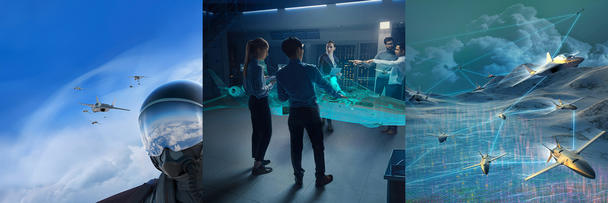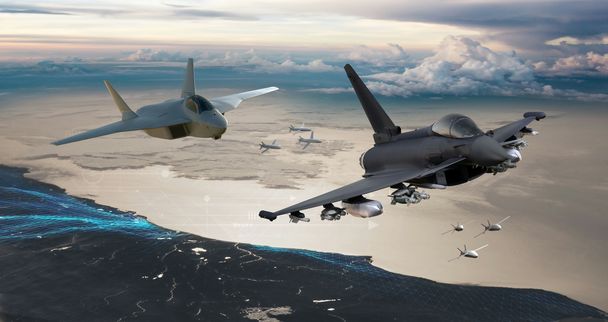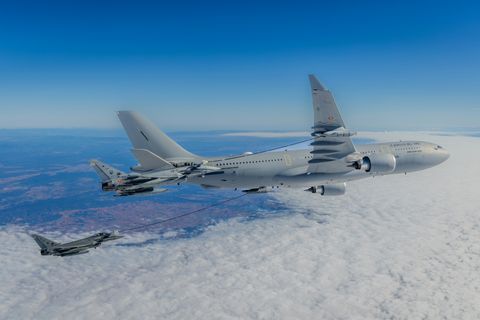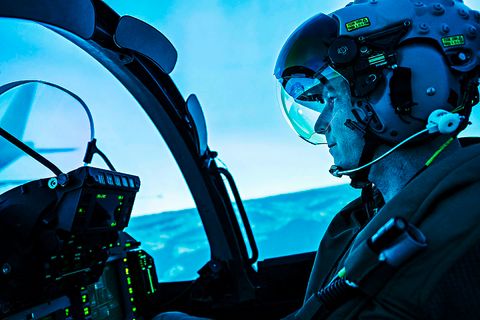Future Combat Air System (FCAS) - Enter the Internet of Military Things

The FCAS Air Combat Cloud will bring real-time intelligence to the forefront by harnessing the networked capabilities of different aircraft and platforms. Innovations in AI, big data processing and cyber will help make defence a truly collaborative mission.
Europe’s Future Combat Air System (FCAS) will see next-generation manned jets flying alongside unmanned remotely piloted carriers of varying sizes. These assets will be part of a fully networked ‘system of systems’ based on open architectures that will allow the integration of other existing platforms such as the A400M or the A330 MRTT tanker. At the heart of this complex system will be the Air Combat Cloud, which will enable these platforms to work together.

But what exactly is an Air Combat Cloud? As FCAS Combat Cloud Product Solution Lead at Airbus, Ignacio Rosell is often asked this question.
“How does the Android ecosystem work? We have an operating system that allows applications from different parties to be integrated, and all of this is supported by a communications infrastructure such as 5G, Bluetooth or Wi-Fi. If we apply this analogy to FCAS, we are developing an important part of the ‘Internet of Military Things’. Our mobile phones could be a fighter aircraft, an unmanned aerial system (UAS), a warship, a satellite, or even a soldier on the ground, each integrating different applications or, in other words, different capabilities. Our air combat cloud has the same components, the communications infrastructure, the operating system and the applications that allow them to operate in a collaborative way,” adds Rosell.
Multi Domain Combat Cloud
A Europe at the forefront of technology
Launched by France, Germany and Spain, and with Airbus, Dassault Aviation and Indra as national industrial coordinators, FCAS is one of the most important European defence programme of the coming decades. In a context of growing global instability, the aim of the project is nothing less than to design an air defence system that will protect Europe while enhancing its strategic autonomy and technological sovereignty.
Speeding up the cycle with learning technologies
Airbus is leading the Combat Cloud pillar, with Thales and Indra as its main partners. This is one of seven areas of the next-generation FCAS technology (*see infographic below the page), headed at Airbus by Marc Paskowski.
It will provide common situational awareness by instantaneously capturing, sharing, fusing and processing massive amounts of data from all connected manned and unmanned platforms in a trusted manner, and transforming this data into actionable information by leveraging the ever-evolving learning technologies. “The concept based on the air cloud is that all elements must constantly interoperate with each other to form a cohesive system that is informed as one and combat as one," says Paskowski.

“Our ‘operating system’ will need to be an open one to accommodate both off-the-shelf and bespoke applications such as manned-unmanned teaming, from Airbus or from any other industrial partner. It will be an evolutionary one, with new applications such as new aerial platforms being integrated along the way,” says Rosell. “Our business model around the Combat Cloud won’t be unique. An area such as satellite connectivity could be offered as a service, while an ‘app’ part of an aircraft’s mission system could be sold as a product,” he adds.
New Generation Fighter and Remote Carriers demonstrators connected to the Combat Cloud are planned for first flight in 2028/2029
The development of intermediate solutions as part of this ‘internet of military things’ should enable customers to use various levels of cloud capabilities and remote carriers well before FCAS becomes operational in the 2040s. For example, Airbus has already carried out the world’s first successful launch and operation of a Remote Carrier flight test demonstrator from a flying A400M.
Remote Carrier demonstrator
For those who secure today and tomorrow: responsible AI for FCAS
Based on this incremental approach, the air combat cloud will be the digital game-changer for the way military operations are conducted.
The ability to integrate, operate and communicate from a networked system will shape the air force of the future.
German Air Force Lieutenant General Ingo Gerhartz
Indeed, future scenarios will require a far higher degree of automation for information management and integration of military services and branches throughout the whole mission cycle. For FCAS, innovations in ‘deep techs’ such as big data processing, artificial intelligence and cyber will provide the advanced intelligence of the cloud, enabling, for example, the distribution of Command and Control (C2) roles, including to the pilot in their fighter, and providing the key players in a mission with all relevant information in real time. “This will give decision makers in the air force an unprecedented level of awareness,” highlights Paskowski.
But with a great power comes great responsibility. With the increasing reliance on artificial intelligence in everything we do as ‘digital citizens’, and the use of platforms such as ChatGPT and its impact in the workplace, the integration of AI at the heart of the FCAS Air Combat Cloud presents new challenges. Questions such as ‘how much will the system support the decision-making process?’ or ’What are the ethical criteria that can be applied to the use of this technology?’

To control or to be controlled: that is the question
In order to anchor ethical questions and legal principles in the FCAS project, Airbus and the Fraunhofer Institute teamed up in 2019 to launch a joint expert commision on the responsible use of technologies (link). It brings together stakeholders from the German Air Force with universities, research institutes and a broad cross-section of foundations, social science and engineering science design experts.
Building on this guidance, within the FCAS Air Combat Cloud, AI will provide analysis of complex situations during multi-domain operations and recommend the smartest action in the right sequence. The human will then validate the recommendations. If the operational tempo is high, the human will instead simply decide whether or not to veto the recommendations, and the subsequent processes will again be automated by the AI. “Our European air defence system will be under the full control of a responsible human operator at all times and in all circumstances,” concludes Marc Paskowski.
The use of AI at Airbus

Airbus began integrating AI into its products and solutions in the 1990s, with applications for reading and interpreting satellite imagery. The OneAtlas imagery services harnesses the power of Airbus’ constellation of optical and radar satellites with trusted AI and cloud technology to provide key insights for example for combating deforestation, optimising agricultural yields and urban planning.
Meanwhile, in the aeronautical sector, Airbus’ Skywise big data platform collects data from 24,000 aircraft parameters, enabling airlines subscribing to the service to carry out predictive maintenance and improve the overall operational efficiency of their fleets.
Technological pillars of FCAS programme
The FCAS programme comprises a total of seven main development areas.




